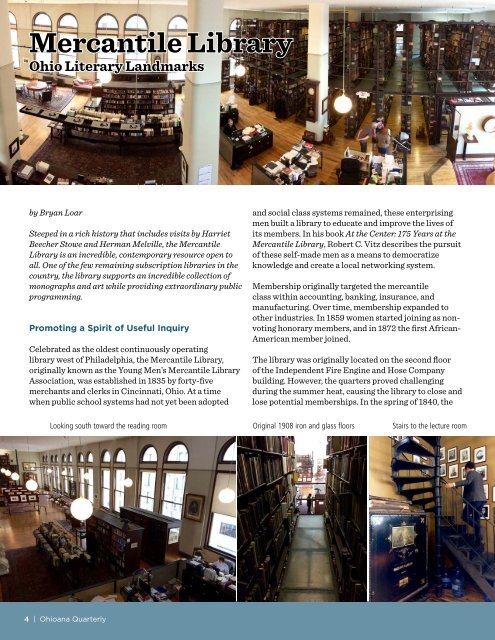QUARTERLY
OQ-Winter-2017
OQ-Winter-2017
Create successful ePaper yourself
Turn your PDF publications into a flip-book with our unique Google optimized e-Paper software.
Mercantile Library<br />
Ohio Literary Landmarks<br />
by Bryan Loar<br />
Steeped in a rich history that includes visits by Harriet<br />
Beecher Stowe and Herman Melville, the Mercantile<br />
Library is an incredible, contemporary resource open to<br />
all. One of the few remaining subscription libraries in the<br />
country, the library supports an incredible collection of<br />
monographs and art while providing extraordinary public<br />
programming.<br />
Promoting a Spirit of Useful Inquiry<br />
Celebrated as the oldest continuously operating<br />
library west of Philadelphia, the Mercantile Library,<br />
originally known as the Young Men’s Mercantile Library<br />
Association, was established in 1835 by forty-five<br />
merchants and clerks in Cincinnati, Ohio. At a time<br />
when public school systems had not yet been adopted<br />
and social class systems remained, these enterprising<br />
men built a library to educate and improve the lives of<br />
its members. In his book At the Center: 175 Years at the<br />
Mercantile Library, Robert C. Vitz describes the pursuit<br />
of these self-made men as a means to democratize<br />
knowledge and create a local networking system.<br />
Membership originally targeted the mercantile<br />
class within accounting, banking, insurance, and<br />
manufacturing. Over time, membership expanded to<br />
other industries. In 1859 women started joining as nonvoting<br />
honorary members, and in 1872 the first African-<br />
American member joined.<br />
The library was originally located on the second floor<br />
of the Independent Fire Engine and Hose Company<br />
building. However, the quarters proved challenging<br />
during the summer heat, causing the library to close and<br />
lose potential memberships. In the spring of 1840, the<br />
association moved into the Cincinnati College building,<br />
sharing quarters with the Medical College of Ohio,<br />
Cincinnati Law College, and the Cincinnati Chamber<br />
of Commerce. Fire destroyed the college’s building in<br />
January 1845, but the quick actions of library members<br />
saved the portrait of William Henry Harrison and all<br />
but seventy-eight volumes of the collection. The college<br />
rebuilt on the same location, and the library committed<br />
to raising $10,000 for the effort. In doing so, the library<br />
bargained for a renewable 10,000-year lease to the<br />
grounds—a lease authored by none other than Alphonso<br />
Taft, father to U.S. President William Howard Taft.<br />
Fire struck again in 1869, and, again, most of the<br />
collection was spared. In 1870 the Cincinnati College<br />
was rebuilt. After thirty-one years in a structure that was<br />
becoming increasingly outdated, Cincinnati College and<br />
the library were approached by Thomas Emery’s Sons,<br />
a company that built its fortune on pork byproducts and<br />
then real estate. The Emerys wanted to build a modern<br />
edifice on the location, and the Mercantile Library, still<br />
owner of the lease, negotiated its placement on the top<br />
two floors along with exclusive use of an elevator. As<br />
a way to further entice the library to move into a new<br />
building, the Emerys suggested the building’s name<br />
honor the library. In 1904, the Mercantile Library<br />
opened in a handsome space with stunning views that<br />
still delights.<br />
From the turn of the century to the late 1960s, the library<br />
went into dormancy and membership dropped to a low<br />
of 323. However, when new director Jean Springer<br />
arrived in 1969, her enthusiasm, programming ideas,<br />
and media savvy helped reinvigorate the library. She<br />
revived lectures by major literary figures and appealed<br />
to younger members through progressive parties.<br />
Springer’s tenure lasted twenty-four years, during which<br />
time she doubled membership and reimagined the<br />
library’s relevance.<br />
Over the next twenty-two years, under the leadership<br />
of Albert Pyle, the Mercantile Library expanded<br />
programming to include civic discussions; significantly<br />
increased attendance to the library’s premier fundraiser,<br />
the Niehoff Lectures; grew membership to over 1,000;<br />
and completed major updates, including the reuse of the<br />
twelfth floor as a lecture room.<br />
Today, membership is affordable, open to all, and enjoyed<br />
by more than 2,500 intellectually curious individuals.<br />
Executive Director John Faherty, Collector Cedric Rose,<br />
Literary Programs and Marketing Manager Amy Hunter,<br />
and library staff are energetic and actively pushing the<br />
library forward. The Mercantile Library continues to<br />
support personal improvement and the exploration of<br />
contemporary ideas through an adaptive and open space,<br />
a notable collection, inspiring art, and extraordinary<br />
programs.<br />
Classically Contemporary<br />
The renovated Mercantile Library is a light-filled<br />
architectural gem. While accents give the library a<br />
Victorian feel, the light, open, and adaptable space is in<br />
line with today’s leading library trends.<br />
Looking south toward the reading room Original 1908 iron and glass floors Stairs to the lecture room Twelfth floor lecture room Reading room facing north<br />
4 | Ohioana Quarterly Winter 2017 | 5


